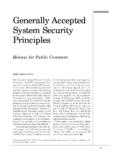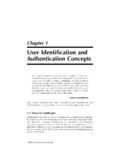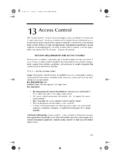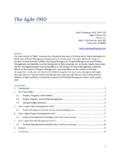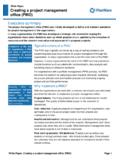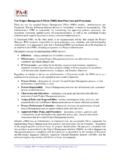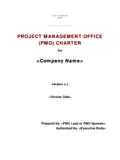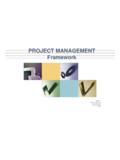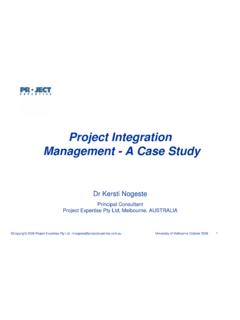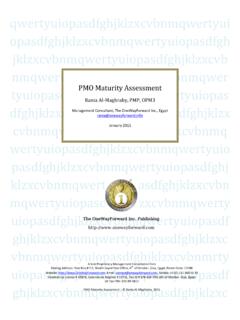Transcription of EVOLVING THE PROJECT MANAGEMENT OFFICE: A …
1 45 INFORMATION SYSTEMS MANAGEMENTFALL 2004 EVOLVING THE PROJECT MANAGEMENT office : A competency CONTINUUMG erard M. HillMany organizations today have recognized the need for a PROJECT MANAGEMENT office (PMO) to achieve PROJECT MANAGEMENT oversight, control, and support. The PMO s role is to help both the PROJECT manager and the relevant organization to not only understand and apply modern PROJECT MANAGEMENT practices, but also to adapt and integrate business interests into the orga-nization s PROJECT MANAGEMENT efforts. This article describes a five-stage competency model for the THE PAST DECADE, MODERN PROJECT MANAGEMENT precepts haveemerged to instill a vitalized profession-al approach to PROJECT managementacross countless industries. Individual capabili-ties in PROJECT MANAGEMENT have been strength-ened and enlarged through a combination ofdevelopments in PROJECT MANAGEMENT processand techniques, the implementation of trainingprograms, and automated tools that use ad-vanced design concepts and organizations today have thereforeimplemented an organizational entity, theproject MANAGEMENT office (PMO), to achieveproject MANAGEMENT oversight, control, sup-port, and alignment.
2 The PMO s role is to helpboth the PROJECT manager and the relevant or-ganization (whether an entire enterprise, abusiness unit, or a department) to understandand apply professional practices of projectmanagement, as well as to adapt and integratebusiness interests into the PROJECT article describes five stages of PMO ca-pabilities along a competency PMO stage suggests a particular level offunctional capability that the PMO will haveachieved if functions are fully five PMO stages are also indicative of an or-ganization s maturity in PROJECT MANAGEMENT ,with the PMO s role and and responsibilitiesadvancing from PROJECT MANAGEMENT oversightand control at the lower end of the competen-cy continuum to strategic business alignmentat the higher competency TO THE PMO competency CONTINUUMThe PMO competency continuum provides avehicle that defines a series of PMO stages thatcan be examined for application in an organiza-tion.
3 The naming convention is relatively sim-ple and somewhat consistent with PMOimplementation efforts across most , these names provide only a frame ofreference; other names can be applied as ap-propriate to the nature of PMO responsibili-ties and the business environment in which M. HILL is Vice President of Technical Services and Support for ESI International. He is a frequent speaker and author on the topic of PROJECT MANAGEMENT and has worked extensively with Fortune 100 executives and managers at all levels to design and deploy PROJECT MANAGEMENT practices. He can be contacted at GOVERNANCEISMFall2004 Book Page 45 Tuesday, August 17, 2004 9:37 2004IS GOVERNANCEFive general stages of PMO competency areprescribed. Figure 1 presents an overview ofthe PMO competency continuum and a de-scription of each of its stages. These five PMOstages represent a progressive competency andadvancement of functionality that can be at-tained to meet the needs of the PROJECT man-agement environment and the associatedbusiness objectives of the relevant organiza-tion.
4 It is presumed that a higher-stage PMOhas already achieved the competencies pre-scribed for any lower-stage PMOs. Thus, if anorganization wants to establish a Stage 3 stan-dard PMO, it will also have to ensure it has firstrealized the competencies prescribed for Stage1 and Stage 2 PMOs. It is also suggested that aPMO at any stage can pursue activities at anylevel to address the needs within the relevantorganization, which is far more important thanstepping through levels of competency in se-quence. Moreover, it is critical to discern theapproximate level of PMO competency thatthe relevant organization needs. Not every or-ganization needs to have a PMO at Stage 5. Infact, for most organizations, the Stage 3 stan-dard PMO is probably more than following subsections provide a de-scriptive overview of each stage in the PMOcompetency 1: THE PROJECT OFFICEThe Stage 1 PMO is the fundamental unit ofproject oversight in the PROJECT managementenvironment.
5 The PROJECT office is created as adomain of the PROJECT manager, who is respon-sible for the successful performance of one ormore projects. It provides the capability to en-sure professionalism and excellence in apply-ing widely accepted principles and preferredproject MANAGEMENT practices to each , more than one PROJECT office mayexist within an organization. When this occurs,an obvious challenge lies in ensuring that eachproject office pursues a common approach toproject MANAGEMENT . Ideally, senior membersof the PROJECT MANAGEMENT staff will collabo-rate in their design and implementation ofproject office capability. Alternatively, a higher-level PMO can be established to guide and sup-port PROJECT office inclusion of the PROJECT office in thePMO competency continuum is arguably anuncertain fit. By definition, it does not influ-ence actions and activities of more than oneproject manager; it has no program-level au-thority or direct strategic business relevance;and it does not fulfill the traditional role of aPMO.
6 However, the PROJECT office implementsand monitors the rules of PROJECT perfor-mance at the PROJECT team level, and that over-sight in itself is a responsibility of PMOs at alllevels. Thus, the placement of the PROJECT officeat the beginning of the PMO competency con-tinuum ensures that effective PROJECT manage-ment oversight at the PROJECT level isconsidered and implemented in the context ofPMO 1 Overview of PMO Capabilities across the PMO competency ContinuumSTRATEGIC ALIGNMENTBUSINESS MATURITYPROCESS SUPPORTPROCESS CONTROLPROJECT OVERSIGHTS tage 3 STANDARDPMOE stablishcapability andinfrastructure tosupport and governa cohesiveprojectenvironmentStage 2 BASIC PMOP rovide astandard andrepeatable PMmethodology foruse across allprojectsStage 1 PROJECTOFFICEA chieve projectdeliverables andobjectives forcost, schedule,and resourceutilizationStage 4 ADVANCEDPMOA pply anintegrated andcomprehensiveprojectmanagementcapabil ity toachieve businessobjectivesStage 5 CENTER OFEXCELLENCEM anagecontinuousimprovement andcross-departmentcollaboration toachieve strategicbusiness goals 1 or more projects Multiple projects Multiple PMs Program Manager Part-time PMOsupport staff Multiple programs Vice President orDirector of ProjectManagement Dedicated PMOtechnical staff Enterprisewide support staff 1 PROJECT Manager PMO Director Dedicated PMOtechnical andsupport staffMultiple projectsMultiple PMsProgramManagers Multiple projectsMultiple PMsProgramManagers Director/SeniorProgram ManagerFull-time andpart-timePMO staff ISMFall2004 Book Page 46 Tuesday, August 17, 2004 9.
7 37 AM47 INFORMATION SYSTEMS MANAGEMENTFALL 2004IS GOVERNANCEThe PROJECT office performs a variety of es-sential PROJECT MANAGEMENT activities, includ-ing: Applying principles and techniques of mod-ern PROJECT MANAGEMENT , through the skilland knowledge of the PROJECT manager, toensure that successful PROJECT performanceis achieved. The PROJECT office concentrateson producing deliverables associated withproject objectives, and it manages the vitalsigns of each PROJECT effort: cost, schedule,and resource utilization. Managing thesedetails invariably enhances examination ofproject performance and facilitates the appli-cation of corrective actions to any problemsthat are identified. Serving as the direct interface to projectteam performance MANAGEMENT . Becausemost PROJECT teams likely have a technicalperformance focus, the PROJECT office willintroduce the elements of PROJECT manage-ment.
8 Accordingly, the PROJECT office pro-vides for differentiation between thetechnical methods, which are prescribed tocreate an excellent technical product, andthe PROJECT MANAGEMENT methods, which areprescribed to ensure PROJECT and businesssuccess. Applying organizational guidance in the formof policies, standards, executive decisions,and so on to each PROJECT effort. The projectoffice also acts as the frontline point of super-vision for implementing and integrating busi-ness processes in the PROJECT managementenvironment. Serving as the first level of PROJECT oversightand, often, the highest level of technicaloversight. Whereas higher-stage PMOs maymandate and introduce technical methodsand procedures, it is the PROJECT office thatimplements them in the PROJECT manage-ment environment. Indeed, at this level,there is probably less emphasis on businessissues, unless the PROJECT manager has thedouble duty of serving also as program PROJECT office s role is that of imple-menter.
9 It carries the policies, practices, andguidance prescribed by higher authority possibly higher-stage PMOs above it into theproject MANAGEMENT environment for projectteam implementation. Yet the PROJECT officedoes not have to achieve advanced levels offunctionality beyond the one or severalprojects it supports. Rather, a PROJECT office canexist formally in name or informally by virtue ofits responsibility for PROJECT and PROJECT 2: THE BASIC PMOThe Stage 2 or basic PMO is the first PMO levelthat deals with multiple PROJECT oversight andcontrol. It furnishes the capability to provideaggregate oversight and control of multipleprojects relative to the performance of multi-ple PROJECT some industries, this stage is traditionallyknown as the program office and representsthe domain of the program manager. It is possi-ble that there could be more than one basicPMO in the relevant organization, one for eachprogram manager.
10 However, it is not practicalfor every program manager to independentlybuild the comprehensive capability that is pre-scribed here. Therefore, in the context of thismodel, the basic PMO is presumed to be thehighest centralized entity of PROJECT manage-ment that pursues its mission under the leader-ship and guidance of one designated basic PMO will likely have minimalstaff, in some cases just one individual assignedto build the PMO s capability. Presumably, thisperson will be assigned full time to the PMO ef-fort and have access to at least a few additionalpart-time support resources. An initiative thatis fully supported financially and appropriatelyresourced typically is able to achieve basicPMO capability and prescribed functionalitywithin one year. This time, however, may varybased on the business commitment and cultureof the relevant an emphasis on establishing control inthe PROJECT MANAGEMENT environment, the ba-sic PMO performs a variety of centralizedproject MANAGEMENT activities, including: Having primary responsibility for establish-ing a standard approach to how PROJECT man-agement is conducted in the relevantorganization.


